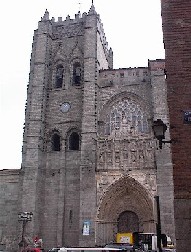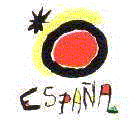

Part 2
Sunday 9 April 2000
It is cloudy again today. After breakfast we take the train to El Escorial.
Here is the palace or monastery of Fe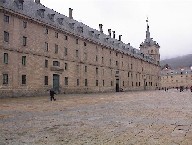 lipe
II. It is located some 50 minutes by train North West of Madrid. The palace is
near the village of San Lorenzo. The building looks a bit grim and forbiding
from the outside and has more in common with a prison than a palace or
monastery. Felipe II had this comlex built between 1563 and 1584 by Juan
Bautista de Toledo and Juan de Herrera. The complex is part monastery, part
mausoleum and part palace, where Felipe wanted to live the life of a monk and
rule the world with two inches of paper. The complex comprises also a church
with over forty chapels and a library and many royal quarters. Underneath the
palace is a mausoleum where kings and princes have been buried. All in all it is
very impresive and worth while the trip. After the visit to the palace we
have a very good and stylish lunch at the restaurant Charoles, just
outside the Escorial.
lipe
II. It is located some 50 minutes by train North West of Madrid. The palace is
near the village of San Lorenzo. The building looks a bit grim and forbiding
from the outside and has more in common with a prison than a palace or
monastery. Felipe II had this comlex built between 1563 and 1584 by Juan
Bautista de Toledo and Juan de Herrera. The complex is part monastery, part
mausoleum and part palace, where Felipe wanted to live the life of a monk and
rule the world with two inches of paper. The complex comprises also a church
with over forty chapels and a library and many royal quarters. Underneath the
palace is a mausoleum where kings and princes have been buried. All in all it is
very impresive and worth while the trip. After the visit to the palace we
have a very good and stylish lunch at the restaurant Charoles, just
outside the Escorial.
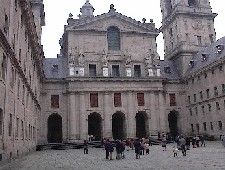
We take the train back to Madrid and have a stroll in the the Parque de
Retiro. The large park at the eastern edge of the city centre. The park started
out as a royal garden. Work began in 1630. The park comprised a zoo for savage
animals, a bird cage, a pond where mock sea battles were staged and an
observatory.
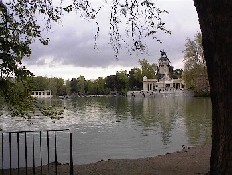 During the Napoleontic wars the French troops took possession of the park,
damaging it badly. After the war the park was restored. After the 1868
revolution it became open to the public. The most important activity in the park
is walking or parading. Busiest time is sunday, when Madrileños turn out in
thousands in there sunday best. Lots of music in the park and of course an
inevitable south american indian band. We get back to the hotel around 6:30.
During the Napoleontic wars the French troops took possession of the park,
damaging it badly. After the war the park was restored. After the 1868
revolution it became open to the public. The most important activity in the park
is walking or parading. Busiest time is sunday, when Madrileños turn out in
thousands in there sunday best. Lots of music in the park and of course an
inevitable south american indian band. We get back to the hotel around 6:30.
At night we have tapas at Taberna de Dolores, as we did yesterday. Wiser by yesterday's experience we do have restaurant reservations. We have lovely paella at Champagneria Gala. The range of variations is overwhelming and it tastes delicious. We are seated in a covered patio. The restaurant does not do coffee, so we have some at the XXX-café. Than it is time for the Sunday Shangay Tea Dance. A dance party, organised by the Shangay magazine at the Pangaso club on Gran Via. It is very busy, especially on the dance floor. We are in luck, because around 12:30am there is a live show by the band OBK, who appear to be very famous in Spain. After the show many make their way home, as it is an working day for most of them the next day, though not for us.
Monday 10 April 2000
Our last day in Madrid. We start with bringing our bagage to the railway
station. We want to buy a ticket for the afternoon train to Avila. That takes an
awful lot of time. We have more than hour's wait. When have managed that we
cross the street to
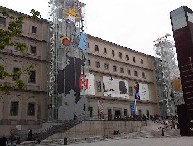 the
Centro de
Arte Reina Sofía. The grand museum for modern Art. The museum owns
primarily on the second floor many works by Picasso, Dalí, Miró and Solana.
The 3rd floor is for temporary exhibitions, while the 4th floor has avant
gardist art.
the
Centro de
Arte Reina Sofía. The grand museum for modern Art. The museum owns
primarily on the second floor many works by Picasso, Dalí, Miró and Solana.
The 3rd floor is for temporary exhibitions, while the 4th floor has avant
gardist art. Main attraction is of course Picasso's Guernica. After a tour around the museum
we have quick snack and get on our way to the train. The train does not leave
from Atocha (where our bagage is) but from Chamartín on the other side of the
city. By metro we get there in the nick of time. The ride to Avila is perfect.
It's sunny but cold when
we get to Avila. We take a taxi to the Parador, where we will spend the night.
The Parador
is based in a 16th century family palace next to the city walls. After having
made ourselves comfortable in our spacious room we go
Main attraction is of course Picasso's Guernica. After a tour around the museum
we have quick snack and get on our way to the train. The train does not leave
from Atocha (where our bagage is) but from Chamartín on the other side of the
city. By metro we get there in the nick of time. The ride to Avila is perfect.
It's sunny but cold when
we get to Avila. We take a taxi to the Parador, where we will spend the night.
The Parador
is based in a 16th century family palace next to the city walls. After having
made ourselves comfortable in our spacious room we go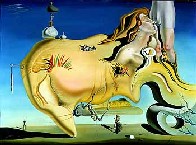 out to check out the town.
We buy some Yemaz de Avila, a local sweet, made of egg yolk and lots of sugar.
Early evening we eat some tapas at Meson del Rastro. Around nine we have dinner
at the Parador. The foord is reasonably good. I have sucking pig. The meat is
nice, but poorly presented. The wine (Marques de Riscal) is excellent.
out to check out the town.
We buy some Yemaz de Avila, a local sweet, made of egg yolk and lots of sugar.
Early evening we eat some tapas at Meson del Rastro. Around nine we have dinner
at the Parador. The foord is reasonably good. I have sucking pig. The meat is
nice, but poorly presented. The wine (Marques de Riscal) is excellent.
Tuesday 11 April 2000
After breakfast we have some coffee. We head for the old city walls. These
are partly accessable
 and
offer fine views of the town and surrounding mountains. After that we have a
look at the cathedral. Construction was started in the 12th century, but it has
never been completed. It lacks one tower. Inside we see that the church has a
Romanesque part and a newer gothic part. The choir is even baroque, while the
organ has rococo elements. The church forms an integral part of the city walls.
We also visit the treasury which holds various artefacts and religious
trinckets.
and
offer fine views of the town and surrounding mountains. After that we have a
look at the cathedral. Construction was started in the 12th century, but it has
never been completed. It lacks one tower. Inside we see that the church has a
Romanesque part and a newer gothic part. The choir is even baroque, while the
organ has rococo elements. The church forms an integral part of the city walls.
We also visit the treasury which holds various artefacts and religious
trinckets.
After a simple lunche we prepare ourselves for the train ride back to Madrid.
We get there by 3:30 and continue straight to the airport. We hang around a bit
before we fly back home to the Netherlands.
